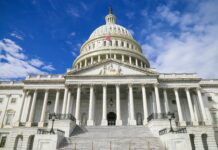
The primary mechanism for ports to unify under a common banner is through the American Association of Port Authorities (AAPA), based strategically in Washington, DC. Advocating for ports in general, while still proudly representing the Port of Corpus Christi, is industry-veteran, Sean Strawbridge. Strawbridge has newly been elected as the Chairman of the Board of the AAPA, and holds ambitious plans for the future as he moves ports to center stage. With an avalanche of negative headlines to mitigate against such as lingering supply chain issues, soaring inflation, the war in Ukraine, a global energy crisis, and intensifying weather and hurricanes, Sean Strawbridge certainly has his work cut out for him.
In this special edition focusing on ports, we sat down with Strawbridge to capture his views on the state of the American port system, his perceived greatest challenges and threats, and a peek into the bold vision he has in mind.

Meet “Mr. Ports” – Sean Strawbridge
Sean Strawbridge is a voracious reader, and starts his mornings in Corpus Christi, Texas flipping through several national and local newspapers “for perspective”. A workout before getting into the office helps the 56-years-young Strawbridge power through a daily schedule that would rival the CEOs of any Fortune-500 company (in reality, that’s exactly what the Port of Corpus Christi Authority is). A hands-on manager who admittedly likes to walk around and “surprise people”, Strawbridge loves to put on his protective gear and go out to be with the field operations crews or plop down in a cubicle with a financial analyst. He takes these opportunities to get candid feedback from all levels of the organization on what’s working and how they can improve.
With the “2022 cost of living crisis” in full swing, and ports bleakly painted front and center during the supply chain woes, Strawbridge takes the helm as Chairman of the Board of the AAPA during a tumultuous time. Undeterred, Strawbridge has an ambitious agenda and what he sees as a unique “window of opportunity”. But, to better understand where he’s heading, we wanted to know from whence he came.
Sean Strawbridge got his start in seaborne transport with a sales position at Sea-Land, a Maersk Company, in the early ’90s. Before he would make his way back to ports, Sean would spend the next several years leading within the C-Suite on a myriad of corporate adventures. He served as the Chief Information Officer and President of National Securities Corporation, led an enterprise resource management (ERM) and transaction processing start-up as President and Chief Executive Officer, and served as Vice President and Controller at a financial services investment bank all before heading to Ports America where he helped lead corporate development efforts.
Sean has continued in global transportation and energy for the better part of a long and storied career. With more than three decades under his belt in critical senior leadership roles across public and private sectors, Strawbridge has proven himself in the trenches of business and corporate development, large-scale infrastructure development, capital structuring and finance, and public-private partnerships. Strawbridge has played key roles at top players in maritime commerce such as the Port of Long Beach, Ports America Group, and Oxbow Energy. This experience has all been brought to a head in his current role as CEO of Port of Corpus Christi, which happens to be the #1 U.S. port in total revenue tonnage. Strawbridge also just so happens to have written extensively on how marine terminals are evolving, as well as paradigm shifts in vessel-based shipping.
As a proud representative of Texas, a seaports veteran, and a media personality who never shies away from talking about all things marine transport, Sean Strawbridge is a bit of an outlier among American port CEOs—which is exactly how he plans to put ports back on the map for the critical infrastructure and national security roles they play across the U.S. Despite ports being so different, it’s up to Strawbridge to look for the commonalities across them to present a unified voice as the new Chairman of the Board of the AAPA.

Mission Number One – Educate the Public on Port Paramountcy
Ask just about anyone what an airport is and they’ll easily tell you, but ask what a seaport is and they may struggle. The Federal Highway Administration pegs the average American as traveling 14,623 miles on highways and byways each year. This may be why roads are what the public thinks of when it comes to getting goods from A to B. And yet, the nation’s maritime ports move more international cargo by weight and value than any other mode of transportation.
When we talk about ports, it isn’t just docks, cranes, and big container ships that may come to mind. The BTS defines the Marine Transport System, as it is called, as “all the waterways, ports, terminals, and intermodal landside connections that allow the movement of people, and goods to, from, and on the water.” That means ports play an absolutely vital role as a connection point between those highways and byways, as well as pipelines, railroads, and other forms of multi-modal transportation.
Different ports have different capabilities as well. Strawbridge tells me there is a saying in the industry – “if you’ve seen one port, you’ve seen one port”. The commodity composition, infrastructure, workforce, surrounding community, and even culture can be vastly different from port to port. The Port of Corpus Christi, for example, can facilitate dry bulk, breakbulk, liquid bulk, and wind energy cargo. They also play critical roles in storage, which is both more complicated and crucial than it sounds. Cargo docks give way to bulk terminals, liquid docks handle crude oil and refined petroleum, and oceanographic studies are conducted and re-conducted all to facilitate multi-modal logistics via the greater port system.
Ports themselves are an interesting quasi-government institution. Most are independently managed but hold a degree of oversight from the municipal government or state in which they find themselves. At the same time, they are relying on the federal government for cooperation with actions like grants used in capital improvement projects (CIPs), harbor deepening with the help of the U.S. Army Corps of Engineers, environmental compliance with the Environmental Protection Agency (EPA), security concerns with the U.S. Coast Guard and Department of Homeland Security (DHS), and even international diplomacy efforts. This means they are simultaneously beholden to local, state, national, and international politics all while trying to accomplish the mission-critical task of keeping American ports open for business and competitive on a global scale.
Running a successful port is a lot like running a successful enterprise-level corporation. Seaport executives manage wide-spanning teams and divisions, from real estate management and engineers to crane operators, develop new business opportunities with prospective clients and foreign dignitaries, and generally try to ensure their port’s voice is heard at the national and international levels among a million and one other day-to-day responsibilities. Manning the helm of a U.S. Port Authority operating 24/7 certainly isn’t for the faint of heart, but Sean Strawbridge shows it can be done exceedingly well—and even with a certain level of panache.
What’s Going on with Ports?
According to the White House’s Transportation Supply Chain Dashboard, the Ports of Los Angeles and Long Beach process upwards of 40 percent of the nation’s containerized imports. In 2021, these two behemoths in the world of seaports moved more goods than ever before. With ports across the country shattering records, one could hardly imagine any trouble in paradise. And yet, the AAPA reports a projected $43 billion investment gap for ports is in store by 2040 if current trends continue.
“If you lift the hood of any economy globally, what you’ll see is ports,” Strawbridge is keen to point out. Simply put, ports drive the economy by providing the ability to move goods to the markets that need them. When ports can’t provide that core functionality, the world sees the widespread implications because it literally hits home with the everyday products our society consumes. In true lemons-to-lemonade fashion, Strawbridge sees this as an opportunity to “use the fragility that’s been highlighted in the supply chain as a launching pad for bipartisan permitting reform and funding.”
There is a bit of duality to Strawbridge’s current roles as both the CEO of a major seaport, as well as Chairman of the Board at AAPA. The balancing act requires finesse, which Strawbridge maintains in abundance. “I’ve been tapped by my peers to lead the association, which means I have to take off my port hat and put on my industry hat.” Someone with so much insight into how vital ports are seems perfectly suited to use the opportunity to catapult ports back into the limelight.
While ambitious, Strawbridge doesn’t think his “areas of focus” during his two-year term at AAPA are far-reaching. A three-pronged approach is his secret sauce for bringing internal and external port stakeholders (which includes all of us) to the table. Strawbridge outlined these as the three focus areas:
- National Freight Policy Reform: Strawbridge aims to lean into the AAPA membership to develop, and eventually have codified with Congress, a more “cogent national freight policy.” COVID made it plain just how fragile the global supply chain is, and how port and transportation-related infrastructure disruptions have a profoundly negative impact on inflation. Strawbridge believes this to be an imminent risk that could and should be addressed with a robust reform of U.S. national freight policy.
- Energy Security & Transition: The global energy insecurity has provided ports a chance to prove how valuable they are to the long-term supply of reliable and secure forms of energy. Similarly, the war in Ukraine has highlighted how very real global energy insecurity is for Europe and around the world. While great strides are continuing to be made in sustainability initiatives, “greener, cleaner”, as Strawbridge calls it, fossil fuels still propel the manufacturing economy.
European powers that were long dependent on Russian oil and natural gas are looking at more favorable and secure energy climates, even if that means buying off-continent, providing a unique window of opportunity for American energy producers. “We want to protect today’s economy and provide for tomorrow,” Strawbridge reiterates.
- Permitting Reform: “Mission critical” is the phrase Strawbridge used when referring to permitting reform. Having long managed seaports, Strawbridge has seen firsthand how developing supporting infrastructure like ports drives the national economy, and yet, it takes twice as long on average to obtain a federal permit for a port infrastructure project as it does to construct the project itself. Permitting reform helps bring certainty to the markets and decision-makers who can truly make national infrastructure reform a reality.

Sean Strawbridge Pro Tip – Leveraging Media Coverage
Perhaps the greatest trick up Sean Strawbridge’s sleeves is his masterful use of media coverage as an outlet to get the word out about ports. An absolute “who’s who” in the world of media giants who have featured Strawbridge include CNBC, Fox News, Fox Business News, ABC News, Wall Street Journal, the Los Angeles Times, the New York Times, and the Washington Post, among many others.
While many might use these platforms for vanity, Sean Strawbridge has made them a utility to help inform the masses. Votes can topple or build empires, and Strawbridge is on a mission to broadcast the strategic importance of seaports and how critical they are for driving the economy. Every Congressional District in the country, and every U.S. territory, relies on ports. We have ports that represent strong alliances with key allies and nearly 200 trading partners around the world. Without ports, goods don’t make it overseas or to U.S. shores.
Meeting global demand with a reliable supply, the U.S. has quickly become the number one exporter for aircraft and aircraft parts. We’re also number one for petroleum, crude oil, and LNG—all made possible by, you guessed it, ports. Energy hubs (especially those in Texas like Corpus Christi) are driving innovation and energy security. Strawbridge sees it as critical to showcase the symbiotic relationship between ports in the U.S. and mainstreet America. Having so many different media platforms gives him the opportunity to inform, educate, and advocate on behalf of the more than 120 Port Authorities who are members at the AAPA. These members represent ports large and small, from Long Beach to Freeport, but each is vitally important in the cargo they handle and the economic impact they make for their respective communities.
Funding Port Modernization
Unfortunately, the “out of sight out of mind” mentality seems to have largely been applied to the vastly strategic U.S. port system. The pandemic highlighted both the criticality of the nation’s ports and the woeful inadequacy with regards to port modernization. Images of backed up container ships made headlines nationwide and many were quick to point a finger at the individual ports themselves. With a recent round of funding, compliments of the Inflation Reduction Act, Port Authorities across the country are finally getting a piece of the transportation funding pipeline. But is it too little, too late?
The latest tranche of funding provided some $700 million to ports. That amount becomes quite paltry with the revelation that it will be divided between some 44 different ports. To put that number in perspective for other infrastructure-related projects around the U.S., here are a few recent examples that made headlines:
- L.A.’s half-mile 6th Street Bridge, which was finished in 2022, cost some $588 million, reports the LA Times.
- In 2020, Salt Lake City spent a staggering $4 billion to rebuild their airport, Deseret News first broke.
- The Florida Department of Transportation plans to spend $2.02 million on a new 0.7-mile sidewalk in a rural Florida county, according to the FDOT Five Year Work Program.
- Phase 1 of a new canal drainage project in North Beach in Corpus Christi carries a price tag of $7 million, reports the Corpus Christi Business News.
“$700 million is a great start. But nowhere near the need,” Strawbridge says. Nearly 30% of our nation’s entire GDP is tied to ports. He went on to explain that unequivocally, seasports facilitate, if not create the opportunity altogether, for the transport of goods on a global scale. They hold national criticality for the economy, national security, energy, and a large degree of foreign policy. That last point has been especially highlighted with the war in Ukraine and subsequent sanctions imposed on Russia, as well as shipping arms and supplies to key allies in the region. To accomplish all of the tasks set forth for seaports, there must be a consistent approach to infrastructure investments.
Doing some quick math, Strawbridge reasoned that if seaports account for 26% of the GDP, and the 2021 U.S. GDP was $23 trillion, per the Bureau of Economic Analysis, nearly $6 trillion (with a T) of the GDP is tied to seaports. $6 trillion against $700 million in funding leaves a bit to be desired. Not to seem ungrateful, Strawbridge is excited to see the funding be put to use and shown just how desperately needed it is. The funding will be available for the various Port Authorities under competitive bids and grants.
Typically, grants are awarded based on need. With how important seaports are socio-economically, they do hold a certain degree of clout. And. as with most things in life, politics do come into play. One port may lobby better for a given project, leaving another port the runner-up in the government’s version of the Hunger Games. The light at the end of the tunnel is the AAPA, which helps even the playing field with fair representation at the national level for ports of all sizes.
Strawbridge sees his role as Chairman of the Board at the AAPA as not so much seeing which port gets what, but rather to recognize that it is Congress who controls the purse and get them to see that current times dictate the purse needs to be opened far wider than it has been historically for ports.
As vessel technology continues to evolve at a lightning pace, so must port infrastructure. Cranes need to be taller, berths made larger, and channels ever-deeper to handle larger classifications of vessels. Ports must also be realistic in what they can achieve so they can be strategic in how they approach improving productivity for the long-haul.

Balancing Relational Complexity Between Constituencies
As we’ve noted, ports are a bit of an oddball when it comes to who owns them. Ports are largely left to states or municipalities for governance even though they are intrinsically linked to our national economy and security. Local governments have their own politics at play and may not fully appreciate how critical port infrastructure is. This can have widespread rippling effects as local constituencies all vie for their own best interests. Strawbridge threw out the example of California ports, which bear the brunt of the American consumer appetite. Residents may not appreciate the congestion or emissions all of the hustle and bustle the container imports initiate and be vocal in their opposition of such to their local government.
Part of the AAPA’s role is to understand what the concerns are for all port stakeholders collectively. By bringing groups to the table like community leaders, social justice activists, business groups, elected officials, and labor unions you let everyone in a community have a voice. The macro and micro-complexities of all of these relationships between various constituencies make seeing the links between them indeed difficult; by bringing everyone to the table, Sean Strawbridge seeks to facilitate widespread community buy-in for just how critical ports are now and will continue to be in the future.
When asked what he saw as his biggest challenge going forward, Strawbridge let out a sigh and was quick to say political instability was perhaps the greatest threat. The inertia causes a terribly detrimental effect on the fiscal success of a port in a given region. Our elected officials need to transcend the political divisiveness that has plagued our country because the political discord has long-term negative impacts on ports, which in turn hurts working American families. His message to politicians: “Let’s agree that we’re not going to agree on everything, but we can agree to disagree without being disagreeable.” Amen, Mr. Ports. Amen.

Author Bio
Tyler Reed began his career in the world of finance managing a portfolio of municipal bonds at the Bank of New York Mellon. Four years later, he led the Marketing and Business Development team at a high-profile civil engineering firm with a focus on energy development in federal, state, and local pursuits and picked up an Executive MBA from the University of Florida along the way. Following an entrepreneurial spirit, he founded a content writing agency servicing marketing agencies, PR firms, and enterprise accounts on a global scale. A sought-after television personality and featured writer in too many leading publications to list, his penchant for research delivers crisp and intelligent prose his audience continually craves.
















